Ergot of Rye: [Characteristics, Cultivation, Diseases and Meaning]
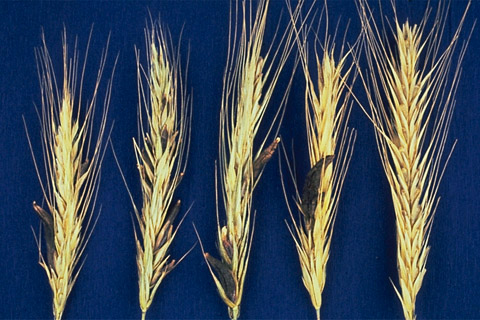
Important points about Ergot in rye:
- What features does it have? The ergot of rye is a fungus of the parasitic ascomycete type, whose scientific name is Claviceps purpurea, it belongs to the clavicipitaceous family and to the Hymenoascomycetes class.
- Where to plant it? Ergot only lives in the ovaries of grasses and cereals and does not affect any other part or organ of the plant.
- When to sow it? In spring, the ergot of rye develops the sclerotia and from them it produces the stromas formed by fungal hyphae conglutinated in a compact mass called plectenchymas where the ascomas are housed.
- What diseases does ergot of rye cause? The ergot of rye infects grasses, especially cereals such as rye, living and using it to make other plants sick and causing serious damage to humans.
- What is the meaning of ergot? The oxytocic effects of ergot and its ability to speed up labor and stop subsequent bleeding have been known since ancient times.
What characteristics does the ergot of rye have?
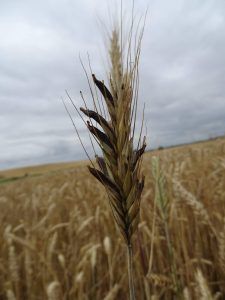 The ergot of rye is a fungus of the parasitic ascomycete type, whose scientific name is Claviceps purpurea, it belongs to the clavicipitaceous family and to the Hymenoascomycetes class.
The ergot of rye is a fungus of the parasitic ascomycete type, whose scientific name is Claviceps purpurea, it belongs to the clavicipitaceous family and to the Hymenoascomycetes class.
It lives and reproduces in the gynoecium of grasses, and transforms its ovary into a resistant structure called sclerotia that is elongated or cylindrical, smooth or faintly striped, made up of fungal hyphae.
The sclerotia of the fungus is a compact mass in the shape of a slightly curved horn (called ergot) that can measure 2-30 mm in length, purplish-black on the outside and white on the inside.
Ergot stands out as an excrescence on the ears of grasses of all kinds, especially rye from which it gets its common name.
On the same sclerotia, several fructifications can sprout and reproduce, made up of a long stem of more than 10 mm, dark brown with lilac tones, at the end of which the ostioles are supported.
The Claviceps genus, to which the rye ergot belongs, is made up of more than 30 phytopathogenic ascomycete fungi that are responsible for parasitizing more than 600 monocotyledonous plants of the wheat, barley, sorghum, rye and rice families.
Ergot produces a large number of active compounds: simple, such as amines or amino acids, and complex, such as polycyclic alkaloids. More than 200 chemical compounds have been identified in a simple ergot extract.
Where to sow ergot?
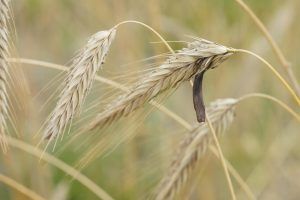 Ergot only lives in the ovaries of grasses and cereals and does not affect any other part or organ of the plant.
Ergot only lives in the ovaries of grasses and cereals and does not affect any other part or organ of the plant.
The conidia produced by the rye ergot during its anamorphic phase or Sphacelia (asexual production for vegetative propagation), are dispersed by insects, which infect other ovaries and other plants.
When ergot reaches maturity (which coincides with fruit ripening on the host plant), the sclerotia fall to the ground where they remain until the following spring. Ripe ears contain both rye grains and ergot sclerotia.
When to sow ergot?
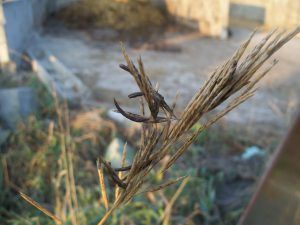 In spring, the rye ergot develops the sclerotia and from them produces the stromata.
In spring, the rye ergot develops the sclerotia and from them produces the stromata.
Formed by fungal hyphae conglutinated in a compact mass called plectenchymas where the ascomas are housed.
The ascomas or perithecia produce thin and elongated asci inside, and form 8 unicellular and filiform ascospores. Once released, the ascospores are ready to go and seed or infect a new plant.
Although ergots (sclerotia) do not usually survive more than a year, rotation with a non-susceptible host plant could be considered a viable management tactic for annual crops.
What diseases does ergot of rye cause?
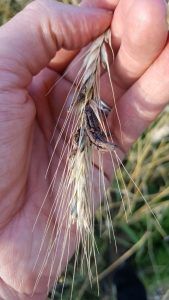 The ergot of rye infects grasses, especially cereals such as rye, living and using it to make other plants sick and causing serious damage to humans.
The ergot of rye infects grasses, especially cereals such as rye, living and using it to make other plants sick and causing serious damage to humans.
In the annals of history there are records that the alkaloids produced by ergot cause «ergotism» in humans.
According to the definition of ergotism, this disease is an «intoxication caused by ergot, which is manifested by nervous and psychic disorders or by vascular disorders», in those who suffer from it .
During the Middle Ages, there were frequent epidemics caused by ergotism, due to the ingestion of ergot-contaminated rye bread. The disease manifested itself with the presence of seizures in the patient and also in a gangrenous form, or both in the same person.
In the years 944 and 995, France suffered the worst epidemic related to ergotism of rye where they lost the lives of more than 60 thousand people.
The disease continued to plague Europe in the 16th and 17th centuries and did not stop until the 19th century, with the introduction of public health policies that encouraged the separation of the fungus from rye, the use of white bread, or potatoes.
The last ergot-related epidemic was recorded in Ethiopia between 1977 and 1978, affecting 144 people, with a mortality of 34%. Important practices have been developed worldwide to combat the presence of ergot in rye.
Some treatments with chemical products of the seeds or the soil of the crop have made it possible to inhibit the production of ascospores from the sclerotia. Unfortunately, chemical methods to kill ergot are not profitable for the production of cereals and grasses.
What is the meaning of ergot?
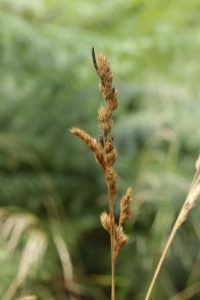 The oxytocic effects of ergot and its ability to speed up labor and stop subsequent bleeding have been known since ancient times.
The oxytocic effects of ergot and its ability to speed up labor and stop subsequent bleeding have been known since ancient times.
Ergotamine, the first alkaloid isolated (1918) from ergot, has an important vasoconstrictor that has been used to combat migraines and to induce abortion, but its effect can also produce thrombosis.
Another alkaloid produced by ergot is ergocryptine, a substance that inhibits the production and release of prolactin, a hormone that promotes the production of breast milk.
It is said that ergocryptine is an active drug against disorders such as Parkinson’s and puerperal and non-puerperal lactation, acromegaly, prolactinomas, among others. The therapeutic and pharmacological effects of ergot have been studied and observed since medieval times.
In recent times, victims of «ergotism» of the convulsive type, which produces ergot, have been associated with accusations of witchcraft that weighed on them, due to the symptoms of the disease.
The convulsions, the violent contractions of the body, the psychic symptoms and the hallucinations, where it was said that they had seen the devil, could make them think that the patients were victims of witches or were possessed.
In Europe there were many cases, which could be associated with ergotism that resulted in cases of witches burned and dilapidated because of their symptoms. In America, the most famous case is reminiscent of the so-called witches of Salem, Massachusetts in 1692, where there was a sudden increase in people accused of witchcraft.
Of these, 8 girls presented uncoordinated language, convulsive movements, shouted profanities, entered a trance and had strange gestures and postures.
The doctors of the time, not finding any scientific explanation for this behavior, suggested that it was witchcraft. At that time, thousands of theories arose about the «Salem Witches» case, including that it was mass hysteria, fraud, etc.
But the cause that has gained more strength, among scientists, is that the young women suffered from the disease of «ergotism» caused by ergot.
Bibliographic references
- The ergot of the rye (I): biology, history and ergotism, C Illana Esteban – 2008 – ebuah.uah.es
- Effects of Ergot Derivatives on the Central Nervous System with Reference to Dopamine Agonist: Lisuride, R Horowski, PA Fischer, YB Frieling – Parkinson’s Disease, 2020 – degruyter.com
- Agriculture and livestock: the case of the ergot, AV Bonome – Anuario brigantino, 1951 – dialnet.unirioja.es
- The alkaloids of ergot and San Antonio, M Martínez – Signos Universitarios, 2014 – p3.usal.edu.ar
- Fluorescence Spectrum of Lysergic Acid and Ergot Alkaloids, GV MOSQUERA – Annals of the Royal Academy of …, 1949 – pubmed.ncbi.nlm.nih.gov

![Photo of Spanish Jasmine Cuttings: [Time, Eradication, Planting and Fertilizer]](https://www.complete-gardening.com/wp-content/uploads/2022/08/spanish-jasmine-cuttings-time-eradication-planting-and-fertilizer-390x220.jpg)
![Photo of Tigernuts: [Cultivation, Irrigation, Care, Pests and Diseases]](https://www.complete-gardening.com/wp-content/uploads/2021/06/Cada-cuanto-regamos-la-chufa-390x220.jpg)
![Photo of Plant a Passion Fruit Plant: [Cultivation, Pruning, Irrigation, Fertilizer and Pests]](https://www.complete-gardening.com/wp-content/uploads/2022/08/plant-a-passion-fruit-plant-cultivation-pruning-irrigation-fertilizer-and-pests-390x220.jpg)
